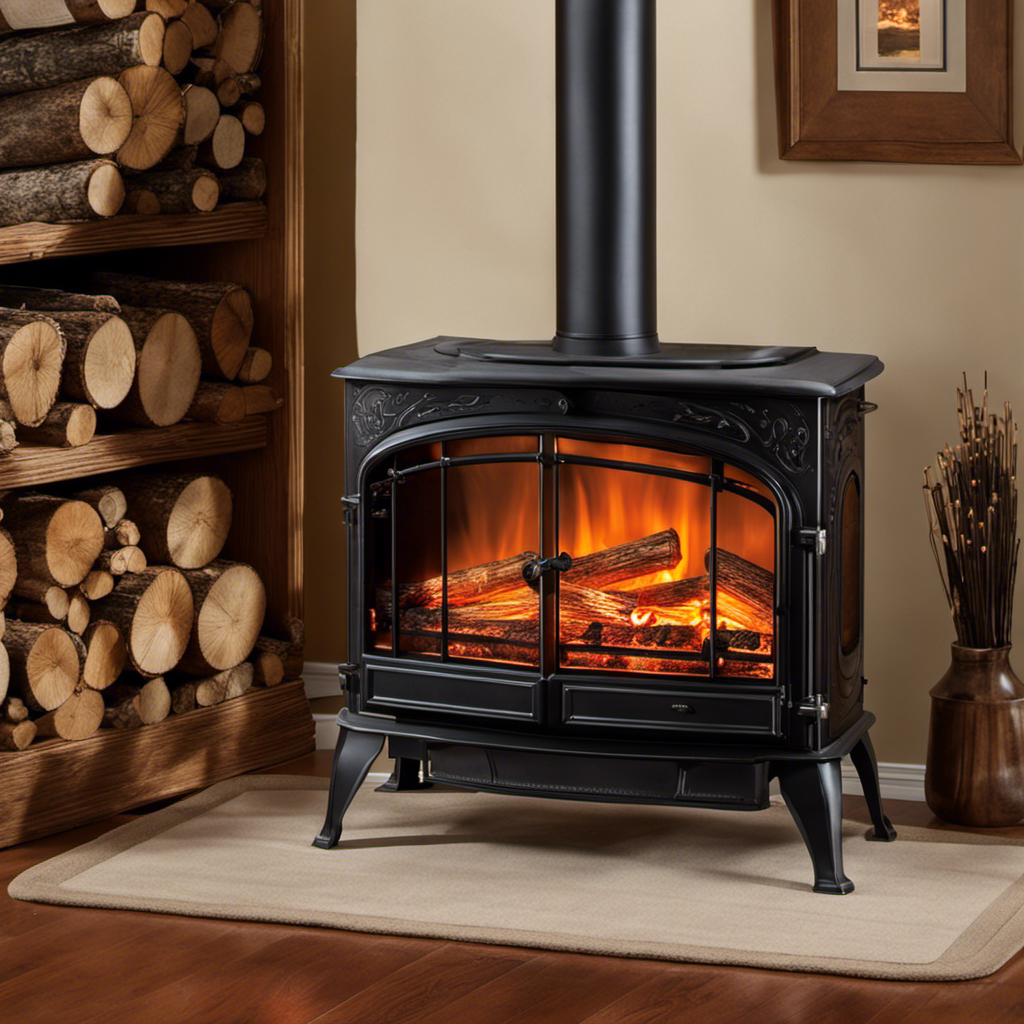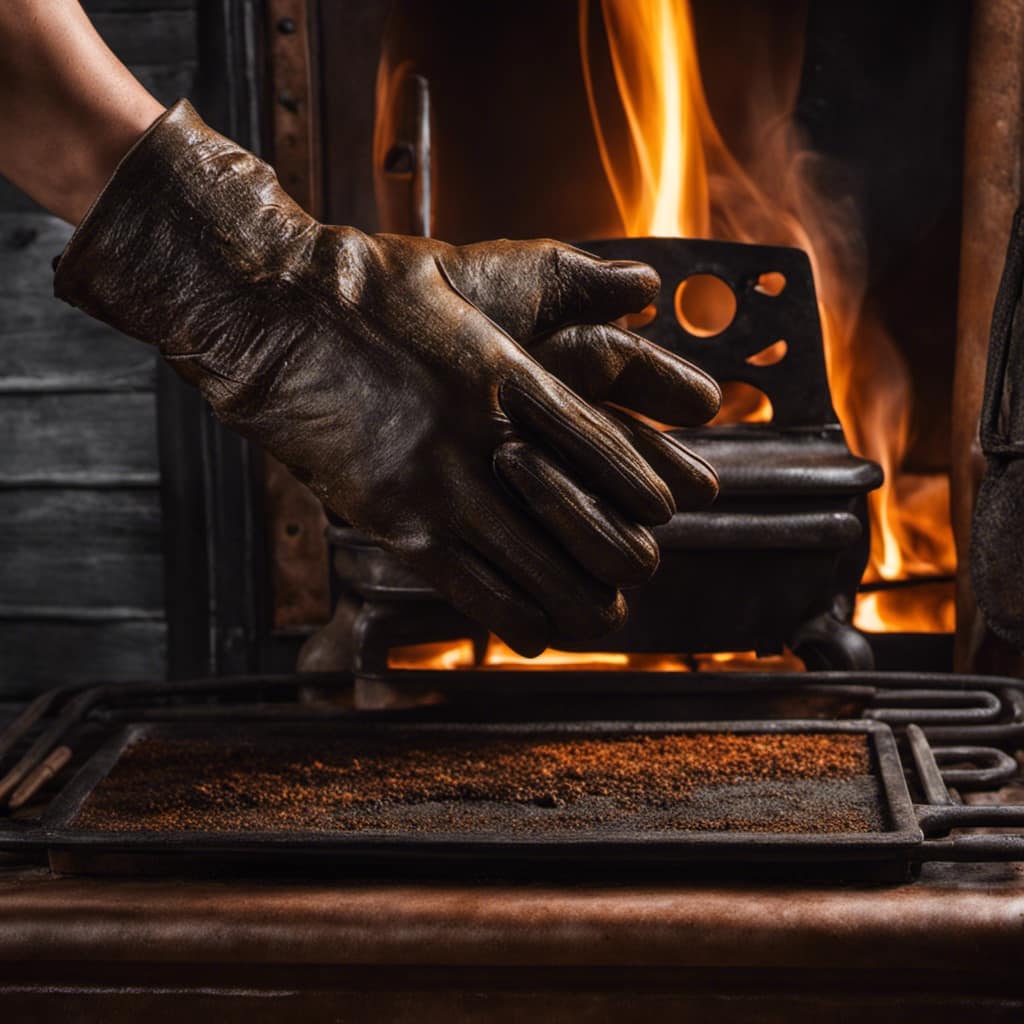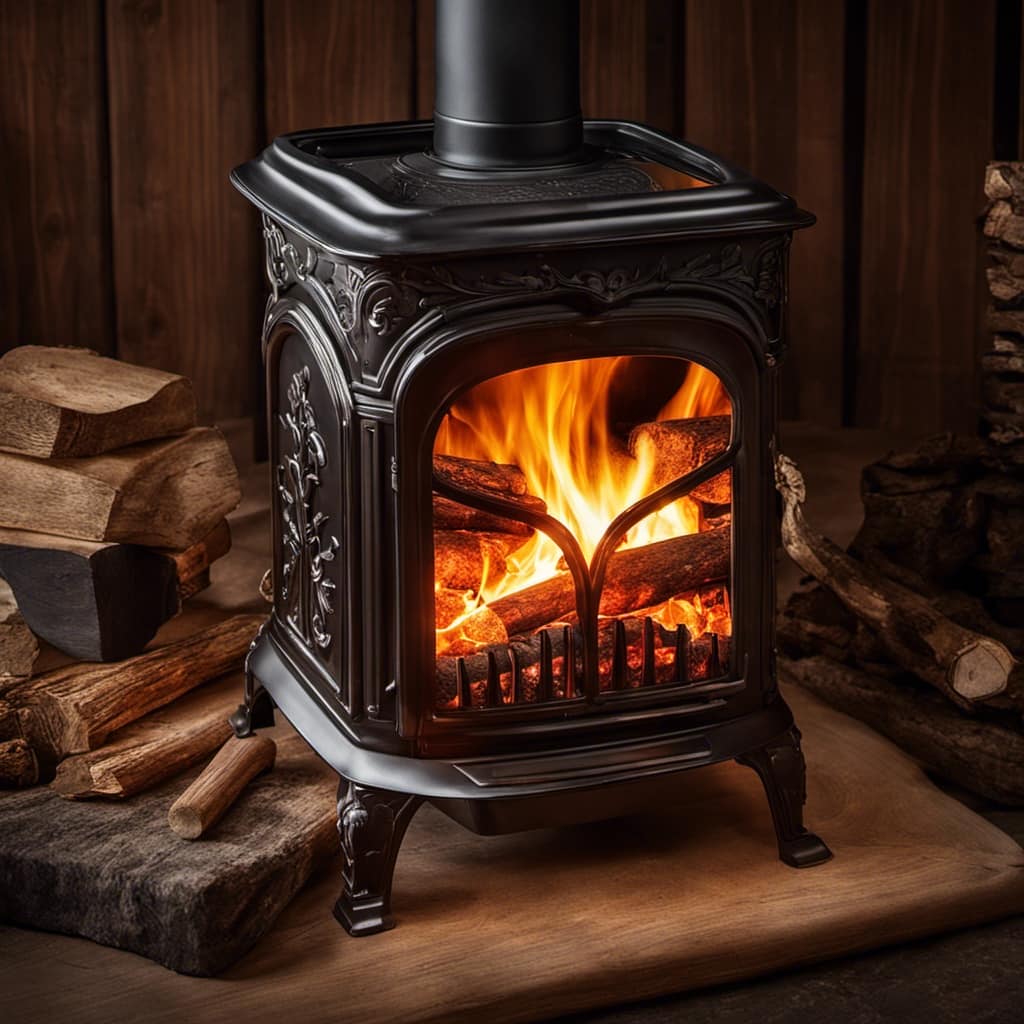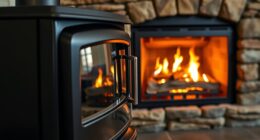As I enter the warm comfort of my house, the atmosphere is enveloped with the calming noise of sizzling. The inviting warmth emanating from a well-maintained wood stove brings a sense of ease, a sensation that comes into being only when the stove hits the ideal temperature.
In this guide, I will share my expertise on how to achieve the perfect heat from your wood stove. Learn the importance of temperature control, the art of efficient preparation, and clever techniques to maximize heat output.
Get ready to enjoy a toasty haven all winter long.
Key Takeaways
- Use air vents and a stove thermometer to regulate and maintain a consistent temperature.
- Clean the chimney regularly and seal any cracks or gaps to ensure efficient heating.
- Use seasoned hardwood for cleaner burning and higher heat production.
- Properly load the stove with logs in a strategic manner to maximize heat output.
Understanding the Importance of Temperature Control
I can’t stress enough the importance of temperature control when operating a wood stove. Proper temperature control ensures not only a comfortable living environment but also efficient and safe operation. To maintain optimal temperature, it’s essential to employ temperature control techniques and troubleshoot temperature fluctuations.
One effective technique is to use the air vents to regulate the flow of oxygen into the stove. By adjusting the vents, you can control the rate of combustion and, consequently, the heat output.
Another technique is to use a stove thermometer to monitor the temperature. This will help you maintain a consistent temperature and avoid overheating or underheating.
If you experience temperature fluctuations, there are a few troubleshooting steps you can take. First, check for obstructions in the chimney or flue that may be affecting airflow. Additionally, ensure that the wood you’re using is properly seasoned and dry, as wet wood can lead to inconsistent burning.
Preparing Your Wood Stove for Efficient Heating
To ensure efficient heating, it’s important to properly clean and inspect your wood stove at least once a year. Regular maintenance is crucial in keeping your wood stove running smoothly and preventing common issues.
Here are four key steps to maintaining your wood stove:
-
Clean the Chimney: A clogged chimney can lead to poor ventilation and inefficient burning. Regularly clean the chimney to remove any creosote buildup.
-
Check for Leaks: Inspect the stove for any cracks or gaps that could cause air leakage. Use a high-temperature sealant to seal any openings and ensure proper combustion.
-
Clean the Ashes: Remove the ashes from the firebox regularly to prevent them from blocking airflow. This will also help maintain efficient burning and prevent excessive smoke.
-
Monitor the Flue: Check the flue for any obstructions or buildup. A clear flue allows for proper airflow and prevents smoke from entering your home.
Using Proper Fuel and Ventilation Techniques
Using proper fuel and ensuring adequate ventilation are essential for maintaining a safe and efficient wood stove operation. Proper maintenance is crucial to avoid any potential hazards and maximize the stove’s performance.
When it comes to fuel, ensure that you only use seasoned hardwood, as it burns cleaner and produces more heat. Avoid using green or unseasoned wood, as it can cause excessive smoke and creosote buildup, leading to poor stove performance and potential chimney fires.
Additionally, regular cleaning and inspection of the stove, chimney, and flue are essential for identifying any issues and preventing blockages. If you encounter any problems, such as difficulty in starting a fire or excessive smoke, consider troubleshooting techniques like checking for air leaks, adjusting the damper, or cleaning the flue.
Maximizing Heat Output With Strategic Loading
Strategically loading the wood stove with well-seasoned logs ensures a consistent and efficient heat output. By following these strategic loading techniques, you can optimize the heat output of your wood stove:
-
Choose the right size logs: Select logs that fit comfortably in your stove without overcrowding or leaving too much empty space. This allows for proper airflow and maximizes heat production.
-
Stack the logs in a crosshatch pattern: Place the logs in a crisscross pattern to create gaps between them. This promotes better air circulation and helps the fire burn more efficiently.
-
Start with smaller logs: Begin by placing smaller logs at the bottom of the stove. These will ignite faster and provide a good base for the larger logs.
-
Add larger logs gradually: As the fire grows, gradually add larger logs to maintain a steady heat output. This prevents the fire from smothering and ensures a longer-lasting, consistent heat.
Maintaining Optimal Temperature Throughout the Burn Cycle
I can ensure optimal temperature throughout the burn cycle by carefully monitoring the airflow and consistently adding fuel to the wood stove.
Maintaining consistent heat in a wood stove is crucial for efficient and effective heating. Temperature fluctuations can occur due to various factors, such as insufficient airflow, improper fuel loading, or a buildup of creosote in the chimney.
To troubleshoot temperature fluctuations, it’s important to first check the airflow. Make sure the damper is fully open and the air vents aren’t blocked. Additionally, ensure that you’re using dry and seasoned wood, as wet or unseasoned wood can lead to poor combustion and temperature inconsistencies.
Regular chimney cleaning is also essential to prevent creosote buildup, which can obstruct airflow and affect temperature regulation.
Frequently Asked Questions
How Often Should I Clean My Wood Stove to Ensure Efficient Heating?
To ensure efficient heating, I clean my wood stove regularly. Proper ventilation is crucial for maintaining its performance. Avoid common mistakes like using flammable materials or neglecting to remove ash buildup.
Can I Use Softwood as Fuel in My Wood Stove?
Yes, you can use softwood as fuel in a wood stove. Softwood burns faster and produces more smoke, but it’s cheaper and more readily available. However, hardwood has advantages in terms of longer burn time and higher heat output. Burning softwood can also have a greater environmental impact due to the higher emission of pollutants.
What Are the Signs That My Wood Stove Is Not Operating at Optimal Temperature?
When my wood stove isn’t operating at optimal temperature, there are signs of poor performance. To troubleshoot, I check for insufficient heat output, slow or no heat circulation, and excessive smoke production.
Can I Leave My Wood Stove Unattended While It’s Burning?
Yes, you can cook on your wood stove, but be cautious and use appropriate cookware. However, using coal as fuel in a wood stove is not recommended as it can create a dangerous situation.
How Long Does It Take for a Wood Stove to Reach Its Optimal Temperature?
It typically takes about 30 minutes for a wood stove to reach its optimal temperature. To ensure efficient heating, proper wood stove maintenance is essential. Here are some tips for starting a fire in a wood stove.
Conclusion
In conclusion, achieving and maintaining the proper temperature in your wood stove is crucial for efficient and effective heating.
By understanding temperature control, preparing your stove, using the right fuel and ventilation techniques, and loading strategically, you can maximize heat output and keep your space warm.
Remember, a well-tuned wood stove has the power to turn the chilliest of rooms into a cozy haven, making it a true winter warrior.
So, embrace the warmth and let your wood stove work its fiery magic!
Growing up surrounded by the vast beauty of nature, Sierra was always drawn to the call of the wild. While others sought the comfort of the familiar, she ventured out, embracing the unpredictable and finding stories in the heartbeat of nature.
At the epicenter of every remarkable venture lies a dynamic team—a fusion of diverse talents, visions, and passions. The essence of Best Small Wood Stoves is crafted and refined by such a trio: Sierra, Logan, and Terra. Their collective expertise has transformed the platform into a leading authority on small wood stoves, radiating warmth and knowledge in equal measure.











